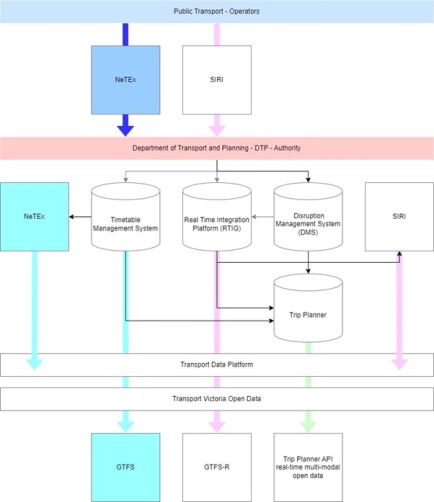Australia: Difference between revisions
Created page with "== Overview in the National Level == == Use cases == === Description === === Architecture === === Use cases === === Outcome ===" |
m Anasfou moved page Draft:Australia to Australia |
||
| (3 intermediate revisions by 2 users not shown) | |||
| Line 1: | Line 1: | ||
== | == Use cases == | ||
The Department of Transport and Planning, located in the state of Victoria, Australia, is working on implementing NeTEx/GTFS for static data and SIRI/GTFS-R for real-time data. Currently, efforts are focused on obtaining endorsement for the technical specification documents related to NeTEx, GTFS, SIRI, and GTFS-R. | |||
In addition, the process of formalizing data change notifications to operators for each of these standards is underway, and the data information requirements document is being finalized. This document will define the high-level roles and responsibilities between operators and the State. | |||
=== Description === | === Description === | ||
The state of Victoria has several modes of public transport which include train, tram and bus. They run in metropolitan areas of the city of Melbourne. Also, in regional towns in the state of Victoria. | |||
To date, a vast majority of contracts that have been entered into between the Victoria State Government either are missing data exchange clauses or are limited in their application and are only suitable for single use cases. This has resulted in limited and inconsistent quality of data. | |||
To ensure the Victoria State Government has an endorsed position relating to Public Transport (PT) data exchange standards governing how data is exchanged across the public transport eco-system. | |||
=== Architecture === | === Architecture === | ||
=== | ==== Future state ==== | ||
The diagram below is the planned target architecture for static and real-time public transport data. | |||
[[File:Australia architecture.jpg|center|thumb|503x503px|Planned target architecture in Australia]] | |||
=== Implementation === | |||
The State Government are working with Operators to embed these data standards into the contractual agreements for modes such as train, tram and bus. | |||
The Department has managed to export NeTEx files from their development environments using the current timetable management system. | |||
GTFS data is currently being published out to third party apps like Google maps, and to the open data market. The Department are currently adding new data configurations based on MobilityData’s framework. | |||
With SIRI and GTFS-R data they are currently being developed in a Proof of Concept (PoC). | |||
=== Outcome === | === Outcome === | ||
The expected results are a richer, consistent, and more accurate quality of public transport data. | |||
Latest revision as of 14:03, 25 September 2024
Use cases
The Department of Transport and Planning, located in the state of Victoria, Australia, is working on implementing NeTEx/GTFS for static data and SIRI/GTFS-R for real-time data. Currently, efforts are focused on obtaining endorsement for the technical specification documents related to NeTEx, GTFS, SIRI, and GTFS-R.
In addition, the process of formalizing data change notifications to operators for each of these standards is underway, and the data information requirements document is being finalized. This document will define the high-level roles and responsibilities between operators and the State.
Description
The state of Victoria has several modes of public transport which include train, tram and bus. They run in metropolitan areas of the city of Melbourne. Also, in regional towns in the state of Victoria.
To date, a vast majority of contracts that have been entered into between the Victoria State Government either are missing data exchange clauses or are limited in their application and are only suitable for single use cases. This has resulted in limited and inconsistent quality of data.
To ensure the Victoria State Government has an endorsed position relating to Public Transport (PT) data exchange standards governing how data is exchanged across the public transport eco-system.
Architecture
Future state
The diagram below is the planned target architecture for static and real-time public transport data.

Implementation
The State Government are working with Operators to embed these data standards into the contractual agreements for modes such as train, tram and bus.
The Department has managed to export NeTEx files from their development environments using the current timetable management system.
GTFS data is currently being published out to third party apps like Google maps, and to the open data market. The Department are currently adding new data configurations based on MobilityData’s framework.
With SIRI and GTFS-R data they are currently being developed in a Proof of Concept (PoC).
Outcome
The expected results are a richer, consistent, and more accurate quality of public transport data.